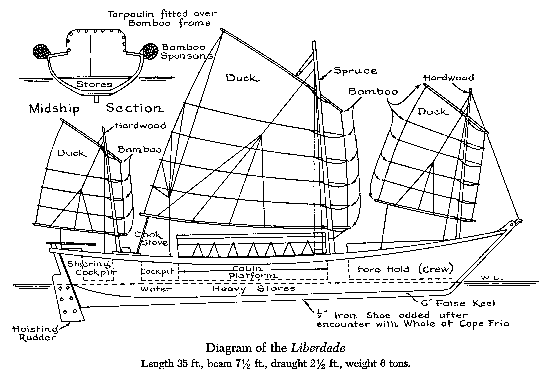Voyage of the Liberdade (1894)by Joshua SlocumJoshua Slocum addressed the reader as follows at the start of Voyage of the Liberdade:
Those two paragraphs are in many ways typical of Slocum, not least in their use of the English language, which is vigorous, poetic, and completely individual. He had left school at the age of eight to work on his father's farm, yet he was remarkably well-read (see, for example, Chapter XIV of this book), and on the basis of his reading during the long watches at sea, his family tradition of lay-preaching, and his experience of the sea and sailors around the world, he developed a literary style that carries the reader along in language that 'has a bone in its mouth'. Until the Hart-Davis edition of Sailing Alone in 1947 included Voyage of the Liberdade the earlier book was little-known on this side of the Atlantic. Arthur Ransome, in his Introduction, stated that he knew of only two copies in England, one in the library of the Cruising Association, the other being in the that of the British Museum. He wrote:
Voyage falls into two equally remarkable halves. The first (Chapters I to VIII) describes the series of appalling misfortunes which befell him as master and owner of the Aquidneck, and culminated in the wreck of the ship on the coast of Brazil and the destitution of Slocum and his family. With typical resolution and optimism he then set about building a sampan-like boat of original design which, with his wife and two sons, he sailed back to the USA, a deep-sea voyage of over five thousand miles. Of that second half Ransome wrote that it is "one of the best stories of a small-boat voyage that have ever been written", a judgment with which it is dificult to disagree, the sheer joy in sailing that it expresses gaining greatly from the contrast with the dark events from which the Slocums were escaping. If Slocum did, as the final note in the book claims, donate the Liberdade to the Smithsonian in Washington, then that august Institution has managed to mislay her. Meanwhile efforts continue to build and sail a replica (see David Sinnett-Jones 'The building and voyages of the Liberdade', Junk Rig Association Newsletter 37, pp. 39-44).

Page maintained by Woll |